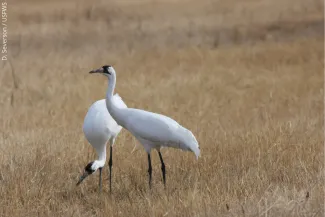
Whooping cranes are spotted in Oklahoma each fall and spring. Help track these endangered birds at wildlifedepartment.com. (D. Severson/USFWS)
Standing five feet tall at the crown, whooping cranes are North America’s tallest and most rare of birds. The last remaining wild flock has been rebuilding for decades; increasing steadily from their low point of 16 birds in 1941. This year, the flock continued to grow.
“The U.S. Fish and Wildlife Service expect 431 whooping cranes will be migrating from their Canadian breeding grounds this year,” said Matt Fullerton, endangered species biologist for the Oklahoma Department of Wildlife Conservation. “All of these birds will pass through Oklahoma at some point this fall.”
The Wildlife Department compiles sightings from Oklahoma’s wildlife enthusiasts each year to help the U.S. Fish and Wildlife Service track this endangered bird’s path across our state.
“Whooping cranes can be reported online and off,” said Fullerton. “Sightings can be shared through our report form at wildlifedepartment.com, or by phone.”
To best help biologists monitor the birds, the date, specific location, and number of birds should be included in each report. Band information (color or number sequence), if any, will allow individual birds to be tracked across the state.
Most whooping cranes are reported in Oklahoma from mid-October through November. Sightings often come from western Oklahoma, typically east of Guymon and west of Interstate 35.
The bird's final destination, Aransas National Wildlife Refuge, was hard hit by the recent hurricane but biologists are optimistic the cranes will adjust to the new conditions. "While rising water levels from Hurricane Harvey changed the coastal marshes the birds depend on, returning cranes should easily be able to find suitable foraging and loafing habitat," Fullerton said.
Contact Fullerton at (580) 571-5820 or Mark Howery, wildlife diversity biologist for the Wildlife Department, at (405) 990-7259 to learn more about whooping cranes or to report a sighting offline.